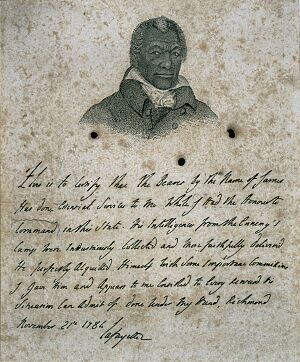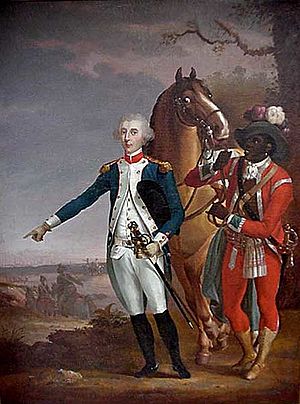James Armistead Lafayette facts for kids
Quick facts for kids James Armistead Lafayette |
|
|---|---|

Engraving of James, c. 1784
|
|
| Allegiance | |
| Active | 1781–1783 |
|
|
|
| Birth name | James Armistead |
| Born | 1748 or 1760 New Kent County or Elizabeth City, Colony of Virginia |
| Died | 1830 or 1832 (aged 70–84) Baltimore, Maryland or Virginia |
| Nationality | American |
James Armistead Lafayette (born around 1748 or 1760 – died 1830 or 1832) was an enslaved African American who played a secret but vital role in the American Revolutionary War. He worked for the Continental Army under General Marquis de Lafayette. James was a double agent, meaning he pretended to spy for one side while actually working for the other. His bravery and cleverness helped the American forces win important battles. After the war, he was granted his freedom by the state of Virginia.
Contents
James's Early Life
James was born into slavery in either North Carolina or Virginia. He became the property of Colonel John Armistead in New Kent County, Virginia. Later, he became the personal servant of the Colonel's son, William Armistead. James learned to read and write, which was unusual for enslaved people at that time. Most historians believe he was born in 1748, but some sources suggest 1760.
A Spy for Freedom: The American Revolution
James's owner, William Armistead, was a strong supporter of American independence. When the Revolutionary War began, Virginia's royal governor offered freedom to enslaved people who joined the British forces. However, James chose to volunteer for the Continental Army, working for General Lafayette.
James's most important role was as a spy. He pretended to be a runaway enslaved person and joined the camp of Benedict Arnold, a former American officer who had switched sides to the British. James gained Arnold's trust, even guiding British troops through local roads. While doing this, he secretly gathered information for the Americans. He was a true double agent, feeding false information to the British while giving accurate details to the Americans.
After Arnold left Virginia in the spring of 1781, James continued his spy work in the camps of British General Lord Charles Cornwallis. The British hired James as a courier, and he often overheard officers openly discussing their battle plans. He wrote down these secrets and delivered them to other American spies. This information about British troop movements and weapons was extremely helpful. His spying was key to helping American and French forces defeat the British during the siege of Yorktown, a major victory that helped end the war.
Gaining His Freedom

Even though Virginia passed a law in 1782 to free enslaved people who fought in the Revolutionary War, James Armistead was not immediately freed. A later law in 1783 only freed those who had carried firearms as soldiers. Since James had served as a spy, not a soldier with a gun, he was not included.
James did not give up. He asked for his freedom with the help of his owner, William Armistead, who was then a member of the Virginia House of Delegates. Most importantly, General Lafayette himself wrote a personal letter in 1784, praising James's brave and valuable service. With this strong support, James's petition was finally approved. On January 9, 1787, Virginia's governor signed the petition, granting James his freedom. To honor the French general who helped him, James added "Lafayette" to his name.
Life After the War

After gaining his freedom, James Lafayette became a farmer in New Kent County, Virginia. He bought two pieces of land, totaling about forty acres, and became a successful farmer. He lived there with his second wife and their children, including a son.
In 1818, James asked the Virginia legislature for a pension because of his service in the Revolutionary War. He eventually received $60 as a one-time payment and an annual pension of $40.
A special moment happened in 1824 when General Lafayette returned to the United States. He toured all 24 states and was celebrated as a hero everywhere he went. While in Richmond, Virginia, Lafayette saw James in a crowd. He immediately stopped his carriage and rushed to embrace James, showing their strong bond and mutual respect.
Remembering a Hero: Death and Legacy
James Armistead Lafayette died in either Baltimore or New Kent County in 1830, or in Virginia in 1832. The exact date and place are not certain.
During his lifetime, James's bravery was mentioned in a historical novel. A French artist, Jean-Baptiste Le Paon, painted a portrait of General Lafayette in 1785 that included a Black servant, which some believe was meant to be James. Later, a portrait of James was painted by John Blennerhassett Martin, and copies were shared along with Lafayette's letter praising James's service. Some also believe that a figure on the Lafayette Memorial in Brooklyn, New York, dedicated in 1917, represents James Lafayette. In 1997, Virginia placed a highway marker near the New Kent County courthouse to honor his important service to the country.
See also
 In Spanish: James Armistead Lafayette para niños
In Spanish: James Armistead Lafayette para niños
- Intelligence in the American Revolutionary War
- Benjamin Tallmadge
- Liberty's Kids, episode 35


